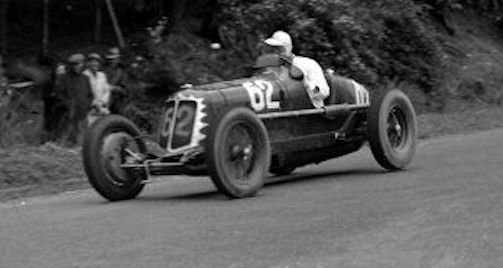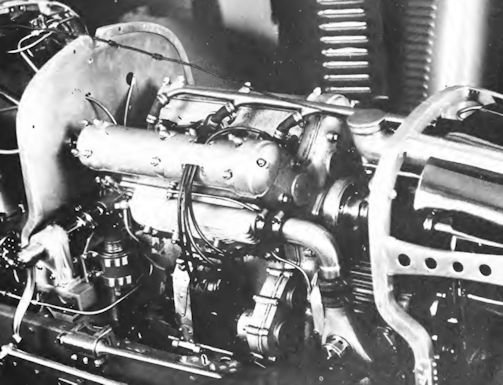Maserati 4CM Race car
 | |
Manufacturer | Maserati |
Production | From 1932 to 1938 |
Class | Race Car |
Frame | two side members and crosspieces in steel sections |
Engine | 4 cylinders in line |
Transmission | 4-speed gearbox plus reverse gear |
Length | 3680 mm (147.2 in) |
Width | 1480 mm (59.2 in) |
Height | 1350 mm (54.0 in) |
Weight Dry | 500 kg (1210 1b) |
The 4CM is a competition car built by Maserati from 1932 to 1938 .
History
The 4CM was produced in different series, which were distinguished by the displacement of the installed engine , which were respectively 1100, 1500, 2000 and 2500 cm³. The 1100 version was the first single-seater built by Maserati, and was assembled from 1932 to 1937 . The 1500 was built from 1934 to 1938 , 2000 in 1933 and 2500 from 1934 to 1937 .
The first 1100 cc monoposto 4-cylinder appeared in late 1931.Chassis numbers ran irregularly from 1118 to 1128 with probably no more than seven being
4CM-1100 models. The 1100 originated from the mechanics of 4CTR , suitably modified and improved. This had also installed hydraulic brakes with two pumps and two circuits, that is a better system than the solutions previously used, that is to say with steel cables . A 440 kg version was prepared , after a 470 kg intermediate, with an engine power of 145 bhp at 6500 rpm . In 1937 the last variant was built, which had the chassis and bodywork similar to the 6CM .
The 1500 was made for the interest in this class, and led to several orders also from abroad .The 2000 was manufactured in a single copy, kept at the Montague Museum in Beaulieu, in 1933. It had a 4- cylinder engine with an exceptional torque spread for most of the rotation speed and had the steering unit positioned laterally to the engine, and therefore the pilot's seat was slightly to the side.
In 1933 a 2500 cm³ engine was built alongside the 2000 from which it derived its origin. It was destined for the Grand Prix category . The engine was then coupled to a decidedly outdated chassis, with mechanically controlled brakes and a little longer than the one installed on the 2000. Also, the 2500 was a unique specimen .
The competitions
The 4CM 1100 took third place at the Nürburgring in 1932 for the 1500 category (first among the 1100 engine capacity), as well as winning other races in other competitions. He also achieved important results with Giuseppe Furmanik with the lighter variant of 470 kg and aerodynamic bodywork made by Viotti . On 3 June 1937 , on the Firenze-Mare , with this car Furmanik managed to conquer the world record on the millet launched for the category 1500, recording the speed of 237.623 km / h, previously set by the American Arthur Duray at 230.621 km / h, on 25 August 1929 .
For the 1500 the competition was stubborn, with the Delage and its 8 cylinders , and the ERA with its 6-cylinder Riley derivation . Despite this the 4CM 1500 imposed itself at the Nürburgring in 1934, when Luigi Castelbarco conquered the victory. Chassis were numbered from 1514 in August 1932 to 1559 in April 1938. About twelve cars were completed.
The first race of 2000 was in 1933 during the Coppa Ciano , and was led by Giuseppe Campari who achieved good results by exploiting its main characteristics, namely road holding and acceleration . The model was then given to Ippolito Berrone who successfully guided it in second-rate European races .
The 2500 was entrusted to Piero Taruffi , who took part in the Monaco Grand Prix retreating while occupying fourth place, best of the Maserati pilots. Afterwards the engine, after a break, was rearranged on a 4CM branch frame. In 1935 the model was retrained and led by Nino Farina . The following year a new sports version was prepared by Carlo Felice Trossi , while in 1937 the 2,500-cylinder engine made its final appearance on a 6CM chassis , driven by László Hartmann .
The body was an aluminium single-seater for the 1100, 1500 and 2000, and a two-seater for the 2500. The chassis consisted of two longitudinal members and cross-members in steel sections, with torsion bars on the front for 1100 .

The engine was a four-cylinder in-line . The displacement was 1088.4 cm³ for the 1100 , 1495.7 cm³ for the 1500 , 1970.4 cm³ for the 2000 and 2482.6 cm³ for the 2500. The bore and stroke were respectively 65 and 82 mm for the 1100 , 69 and 100 mm for the 1500, 80 and 98 mm for the 2000 , 84 and 112 mm for the 2500 . The compression ratio was between 5: 1 and 6: 1 for the 1100 , 6: 1 for the 1500, 5.8: 1 for 2000 and for 2500. The maximum power supplied by the engine was 90-125 bhp at 5300-6000 rpm for the 1100, 130-150 bhp at 5600-6000 rpm for the 1500, 165 bhp at 5500 rpm at minute for 2000 and 195 hp at 5300 rpm for 2500.The ignition was single with Scintilla magnet . The power supply was forced with a Roots type compressor . The distribution consisted of two valves per cylinder arranged at 90 ° V, with a double overhead camshaft . The lubrication was forced with pressure and scavenge pumps. The cooling system had water circulation with centrifugal pumps .The 1100 reached a maximum speed of 146 km / h , the 1500 reached 190-230 km / h , the 2000 at 215 km / h and the 2500 at 220 km / h .
The brakes were drum-type on wheels with hydraulic control. The suspension consisted of leaf springs and friction dampers . The steering was worm and toothed sector. The transmission was formed by a change in 4 plus reverse relations .
Rating
Technical
-
Maserati 4CM Technical details and specifications (1932-1938)
4CM-1100
ENGINE:
CYLINDERS: 4 in line supercharged
BORE & STROKE: 65 mm x 82 mm (2.6 in x 3.3 in)
DISPLACEMENT: 1088 cc (65.3 cu in)
COMPRESSION RATIO: 6 : 1
FUEL CONSUMPTION: 25 litres per 100 km (10.9 mpg)PERFORMANCE:
MAXIMUM BHP: 125
MAXIMUM RPM: 6600
MAXIMUM SPEED: 210 kph 126 mph)DIMENSIONS AND WEIGHT:
WHEELBASE: 2400 mm (96 in)
FRONT TRACK: 1200 mm (48 in)
REAR TRACK: 1200 mm (48 in)
DRY WEIGHT: 480 kg (1056 1b)
KERB WEIGHT: 530 kg (1166 1b)
OVERALL LENGTH: 3680 mm (147.2 in)
OVERALL WIDTH: 1480 mm (59.2 in)
OVERALL HEIGHT: 1350 mm (54 in)
FUEL CAPACITY: 115 litres (25.3 imp galls)WHEELS TYRES:
TYRE SIZE: 5.50 x 16 front, 5.00 x 17 rear4CM-1500
ENGINE:
CYLINDERS: 4 in line supercharged
BORE & STROKE: 69 mm x 100 mm (2.8 in x 4.0 in)
DISPLACEMENT: 1496 cc (89.8 cu in)
COMPRESSION RATIO: 6 : 1PERFORMANCE:
MAXIMUM BHP: 150
MAXIMUM RPM: 6100
MAXIMUM SPEED: 220 kph (132 mph)
FUEL CONSUMPTION: 15 litres per 100 km (18.18 mpg)
DIMENSIONS AND WEIGHT:
WHEELBASE: 2400 mm (96 in)
FRONT TRACK: 1200 mm (48 in)
REAR TRACK: 1200 mm (48 in)
DRY WEIGHT: 500 kg (1100 1b)
KERB WEIGHT: 550 kg (1210 1b)
OVERALL LENGTH: 3680 mm (147.2 in)
OVERALL WIDTH: 1480 mm (59.2 in)
OVERALL HEIGHT: 1350 mm (54.0 in)
FUEL CAPACITY: 115 litres (25.3 imp galls)WHEELS TYRES:
TYRE SIZE: 6.00 x 16 front, 5.25 x 17 rear© Motor car History




